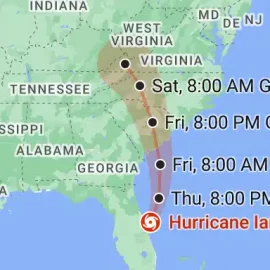
We have been cleaning up our air with less pollution and now we find out our good deed is not going unpunished as that means more hurricanes.
No good deed goes unpunished. New NOAA research has found that the dramatic reductions in air pollution in North America and Europe during the past four decades is likely linked to a similarly steep increase in the number of hurricanes in the Atlantic, including the Gulf of Mexico. And the research also shows that in Asia, where industrial development in India and China is booming without similar emission controls, the increased pollution has resulted in fewer hurricanes. “We know that air pollution is not good for human health, because it accelerates lung diseases and cancer. So we try to decrease emissions because of human health problems,” said Hiroyuki Murakami, a scientist with NOAA’s Geophysical Fluid Dynamics Laboratory in Princeton, N.J., and author of the study, during an interview on Wednesday. “But reducing aerosols led to the increased cost of cyclones in some regions, and that is something we didn’t expect,” he said.
nola.com
In other words, the more particles in the air the fewer big storms. Who would have known?
The changes in storm frequency are linked to the amount of human-created particulate aerosols – tiny particles and droplets contained in the emissions of cars, trucks, airplanes, power plants and industrial operations – according to the study published in the journal Science Advances on Wednesday. When the amount of particulate matter in North America and Europe dropped by 50% between 1980 and 2020, fewer particles were blocking the sun’s rays, which increased the temperature of water in the Atlantic Ocean. The warmer water increased the upward flow of moist air, which helped spur the development of the thunderstorms that create tropical systems, and the water’s warmth provided the energy that fueled a 34% increase in the number of tropical systems.
It is not only the clean air but the winds that cross the land.
And warming of air temperatures over land and water in the northernmost latitudes of North America, Europe and the Atlantic also resulted in a poleward shift of the Jet Stream in that area. That’s resulted in weakening of westerly blowing winds in the upper troposphere — about 10 to 12 miles above the surface — in the part of the Atlantic basin where storms form. That poleward shift of the Jet Stream, plus the lower air pressures that resulted in more upward movement of air in the northern Atlantic, also has led to higher air pressures across the southern hemisphere. That caused a downward motion of air that resulted in fewer hurricanes south of the Equator, including near Australia. In the western North Pacific, increased industrial development during the same 40 years, combined with fewer pollution abatement measures, resulted in a 40% increase in aerosol particles and droplets in the atmosphere. The particles blocked the suns’ rays from reaching the ocean surface, and led to cooler water temperatures and fewer storms — and 14% fewer typhoons, the study concluded.
These changes are additive rather than single phenomenon.
Morikami said the increase in storms in the Atlantic basin from the human-caused aerosol effects are in addition to changes in the number of storms each year caused by a separate, natural phenomenon. That phenomenon, involving water currents and associated water temperature changes in the Atlantic, is called the Atlantic Multi-Decadal Oscillation. Scientists say the oscilllation creates 25- to 45-year periods of more-active hurricane seasons, followed by similar periods of less-active hurricane seasons. The most recent more-active period began in 1995. Morikami studied both the actual records of hurricane seasons during the 40-year period, and complex longer-term modeling based on that record, to determine that the decrease or increase in air pollution was responsible for measureable increases and decreases in the number of tropical systems in different parts of the globe. He said the aerosol effects are separate from recently identified links between global warming — higher global temperatures linked to increases in carbon dioxide — and a variety of effects on hurricanes.
Another factor is global warming which has effects as well.
Global warming has been linked to: Hurricanes becoming more intense over time, resulting in more storms reaching Category 3 intensity, with winds of at least 111 mph, Storms slowing as they make landfall, which has resulted in greater damage in areas closer to shorelines and Tropical storms and hurricanes producing more rainfall, with potentially devastating effects inland from landfall locations
In short, we do well in one area and it impacts another. Isn’t nature fantastic!



